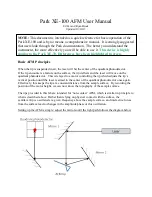
12
IV. . BASIC OPERATION
1. Illumination Controls (Fig. 3)
B
Power switch
C
Brightness control knob
The power switch (1) for the illuminator and the brightness
control knob (2) are located on the microscope base. The
electrical system is fuse-protected and the fuse holder is
located on the power supply socket.
Turn on the light with the power switch (1). If the light does
not appear, check the brightness control (2) to see if it‘s on a
sufficiently low setting.
2. Focusing Controls (Fig. 4)
B
Coarse focusing knob
C
Limit knob (up stop, pre-focusing lever)
D
Knob for tensional adjustment of focusing
E
Fine focusing knob
1) Focusing adjustment: Focusing adjustment is
accomplished by using the large coarse adjustment knobs
(1) located comfortably on each side of the frame. Fine
adjustment is accomplished using the smaller knobs (4)
located on the same focusing shaft. This coaxial
arrangement allows for easy, precise adjustment without
drift or discomfort.
2) Focus control: Turning either of the coarse focusing
knobs (1) will raise or lower the stage. The smallest gra-
duation on the index scale of the fine focusing knob (4) is
approximately 0.7 µm of vertical.
3) Focusing tension adjustment: The tension of the coar-
se focusing knob is adjustable and preset by the factory
for ease of use. If you wish to adjust the coarse focusing
tension, first locate the ringed tension adjustment knob
(3). It is located between the frame and the right coarse
focusing knob. Turning the knob toward the rear of the
microscope increases the tension, and toward the front of
the microscope loosens it. The tension is too high if you
experience physical discomfort.
4) Pre-focusing or focus stop control: The use of this
feature will insure that the shorter working distance
objectives don‘t contact the stage or specimen when using
the microscope. Also, its use simplifies focusing. After
focusing on the specimen with the coarse focusing knob
by a low magnification eyepiece, turning up and fastening
of the lever (2) will set an upper limit on the coarse focu-
sing movement. After changing specimens or objectives,
focusing is easily accomplished by rotating the coarse
focusing knob to reach the pre-focused position. Then
make fine adjustments with the fine focusing knob.
Focusing movement with the fine focusing knob isn‘t
affected by using the pre-focusing lever.
3. Interpupillary Distance and Diopter Adjustments (Fig.
5)
Fig. 5
B
Binocular tube
C
Diopter adjustment ring
1) Interpupillary distance adjustment: The proper inter-
pupillary distance, or the distance between the eyepi-
eces, is crucial to the comfort of the user. Adjusting the
interpupillary distance is accomplished via a „folding“
action of the binocular tube (1), allowing for quick and easy
adjustment.
2) Diopter adjustment: The proper correction for the
individual vision is accomplished by the diopter adjustment
located at the left eyepiece. Using the objective with 40x
magnification, close your left eye and bring an image in-
to focus with your right eye only. Once the image is well
focused, observe with the left eye and make fine
adjustments with the diopter adjustment ring (2) to correct
for your vision.
B
C
C
B
D
E
E
B
B
C
Fig. 4
Fig. 3


































